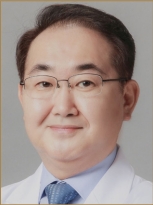Insoo Kim
The extraforaminal region at the lumbosacral junction is difficult to access due to the narrow corridor and its deep location. Therefore, it is easy to overlook symptomatic extraforaminal stenosis of the lumbosacral junction, known as far-out syndrome or Bertolotti syndrome, in conventional magnetic resonance imaging [
1]. This pathology may thus be considered in cases of failed back surgery syndrome with L5 root symptoms.
Decompressive microscopic surgery through the paraspinal approach has been performed for extraforaminal stenosis, but it has its own problems, including postoperative radicular pain, dysesthesia, and a limited field of view leading to incomplete decompression [
2]. Fusion surgery with total facetectomy is sometimes considered.
Endoscopic spine surgery, which has many advantages including less postoperative pain with small incision and less soft tissue injury, short hospitalization, rapid functional recovery, and the possibility of being performed without general anesthesia in some cases, is popular among spine surgeons worldwide [
3-
5]. Moreover, its technical and instrumental advancements have been tremendous. The authors introduced the unilateral biportal endoscopic (UBE) technique for extraforaminal stenosis at the L5–S1 level [
6]. The high quality of endoscopic imaging and application of a continuous irrigation fluid system make it possible to access any lesions around the foramen and extraforaminal region easily [
2]. The approach to extraforaminal lesions, including L5–S1, is sometimes challenging with conventional microscopes or endoscopes due to the iliac crest and hypertrophied L5 transverse process or sacral ala, which are major obstacles. Because the dual portals can be moved independently and are not interrupted by the endoscope, UBE may be feasible for pathology at narrow and deep locations.
As the authors described 3 compression points for extraforaminal stenosis at L5–S1—the pseudoarticulation between the L5 transverse process and sacral ala, the osteophyte and disc bulging, and the thickened lumbosacral and extraforaminal ligament—it is necessary to consider those factors in cases of insufficient decompression. Although UBE is a developing endoscopic surgical technique and has expanding surgical indications for spine surgery, research targeting specific topics, such as the safe bone working limit and fluid pressure relationship, should be conducted. Prospective or randomized studies, as well as those with long-term follow-up results, are mandatory. Thanks to the authors, we have another weapon for challenging pathology. I congratulate the authors for their pioneering endoscopic surgery technique.
CONFLICT OF INTEREST
The authors have nothing to disclose.
REFERENCES
2. Ahn JS, Lee HJ, Choi DJ, et al. Extraforaminal approach of biportal endoscopic spinal surgery: a new endoscopic technique for transforaminal decompression and discectomy. J Neurosurg Spine 2018 28:492-8.



























